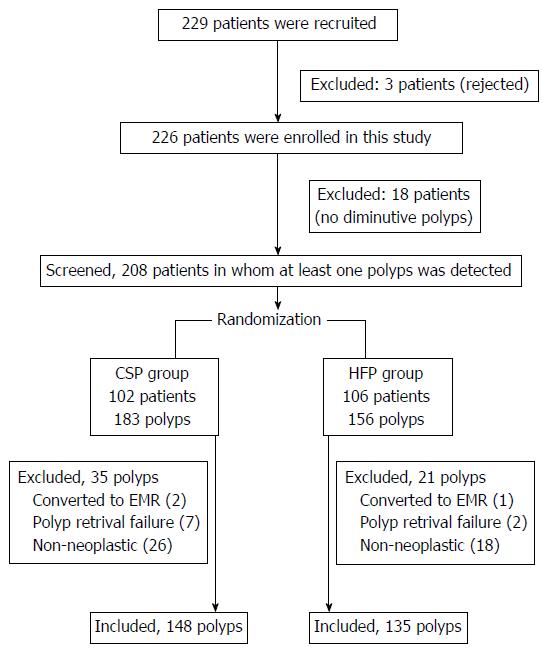Copyright
©The Author(s) 2017.
World J Gastroenterol. Jan 14, 2017; 23(2): 328-335
Published online Jan 14, 2017. doi: 10.3748/wjg.v23.i2.328
Published online Jan 14, 2017. doi: 10.3748/wjg.v23.i2.328
Figure 1 Enrollment flowchart.
CSP: Cold snare polypectomy; HFB: Hot forceps biopsy; EMR: Endoscopic mucosal resection.
Figure 2 Technique for cold snare polypectomy.
A: Chromoendoscopy was used to detect the polyp and surrounding normal mucosa, which were captured with a snare, and resection was performed without electrocautery; B: The mucosal defect was assessed to ensure complete resection and no persistent bleeding; C: The free cut-margin was negative for neoplastic tissue (area between the arrows).
Figure 3 Technique for hot forceps biopsy.
A: A slightly protruded polyp was detected with magnified chromoendoscopy; B: The polyp was captured in the cup of the forceps and gently pulled from the mucosa; C: The electrocautery current was applied to the polyp until the color changed to white at the polyp base. Then the polyp was completely removed from the mucosa; D: Pathologic evaluation of the free cut-margin was difficult to perform because of a thermal tissue injury (arrow).
- Citation: Komeda Y, Kashida H, Sakurai T, Tribonias G, Okamoto K, Kono M, Yamada M, Adachi T, Mine H, Nagai T, Asakuma Y, Hagiwara S, Matsui S, Watanabe T, Kitano M, Chikugo T, Chiba Y, Kudo M. Removal of diminutive colorectal polyps: A prospective randomized clinical trial between cold snare polypectomy and hot forceps biopsy. World J Gastroenterol 2017; 23(2): 328-335
- URL: https://www.wjgnet.com/1007-9327/full/v23/i2/328.htm
- DOI: https://dx.doi.org/10.3748/wjg.v23.i2.328











